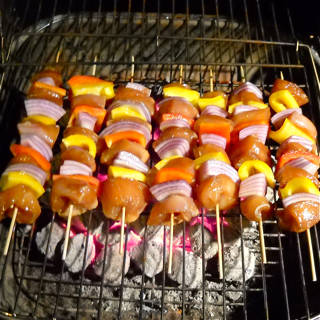Kebabs offer an easy option for all tastes
COOKING FOOD ON a stick over an open flame has been done for centuries. Some claim medieval Turkish soldiers started it by using their swords to grill meat over field fires. Others say it goes back to ancient Greece and developed because of limited cooking fuel. Nowadays meat kebabs are found around the world: yakitori in Japan, satay in Indonesia, sosatie in South Africa. But kebabs don’t need to be limited to meat. Fish and vegetables can be skewered and cooked this way too, satisfying a variety of dietary needs. And since kebabs can be prepared ahead and cooked at the last minute, they’re an ideal choice for entertaining. 
Grilling is the preferred method of cooking kebabs. Before you get started, check that you have enough fuel or charcoal, and give the grill a quick brush to clean it.
Decide on your stick. Disposable bamboo skewers are readily available but need to be soaked for at least 30 minutes before using to prevent them from catching fire. Stainless steel skewers are an investment, but they’re reusable and require no soaking. If you go with steel, look for flat or double-pronged skewers, as they stop food from rotating during cooking — a particular challenge for seafood or fruit.
Always cut meat or seafood into samesized chunks—1 to 2 inches—so it cooks evenly. Since vegetables cook at different rates than meat or fish, people sometimes make kebabs with single items (all meat or all vegetables). It’s more colorful and nutritious to combine items; it just takes a little planning.
Prawns, scallops and other seafood are best combined with contrasting pieces of fish (salmon with halibut, for instance) or with quick-cooking or soft items (fruit, strips of green onion, chunks of tinned artichokes). Lamb, beef and chicken pair well with vegetables that won’t overcook quickly but are also delicious cooked or raw. A classic example is chunks of peppers and onions with lamb, beef or chicken. Pressed tofu cooked on a medium high barbecue needs only warming and crusting, but can handle being grilled long enough to cook small mushrooms, thin zucchini rounds and cherry tomatoes. Experimentation and flexibility are the name of the game.
When combining meat and vegetables on kebabs, before skewering the vegetables, either brush them with a little oil or toss them with the marinade. A little liquid keeps them from drying out during cooking.
For appetizer kebabs, use shorter skewers — 6 inches to indicate they’re a starter, and allow two to three skewers per person. Starter kebabs are generally eaten directly from the skewer, so provide napkins. For main-course kebabs, use 10- to 12-inch skewers. Portion sizes depend on appetites. Generally, five chunks of protein result in one 6-ounce skewer; two skewers per person is a very generous serving. Since main-course kebabs are generally eaten at the table, the meat and vegetables
are usually pulled from the skewer and onto the plate with the tines of a fork.

